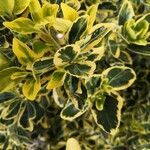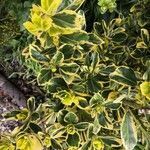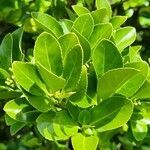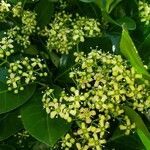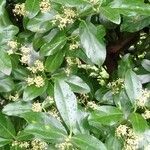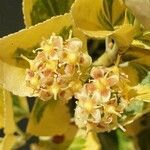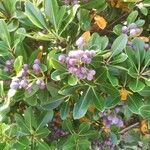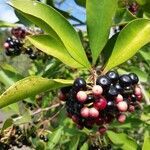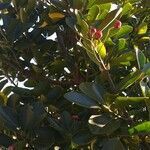Evergreen shrubs or small trees, erect, to 3 m tall, sometimes dwarfed; branches gray-green to gray-brown, terete, glabrous, sturdy, twigs green to light green, glabrous, not evidently striate, especially when fresh. Petiole 3-10 mm; leaf blade leathery or thickly leathery, ovate, obovate, orbicular-ovate, or long ovate, (3-)5-10(-12) × (2-)3-5(-5.5) cm, base orbicular or semiorbicular, margin crenulate distally, nearly entire proximally, apex orbicular or semiorbicular; lateral veins 6-8 pairs, slightly visible or unclear, especially when dry. Cymes usually axillary, sometimes terminal, many branched with many flowers; peduncle up to 8 cm, sub-branches 2-4 cm; pedicel 4-7 mm. Flowers 4-merous, 5-6 mm in diam.; sepals nearly orbicular; petals green or yellowish green, sometimes cream, nearly orbicular. Capsule globose or subglobose, brown or yellow-brown to red-brown, 6-9(-12) mm in diam., 4-lobed. Seeds 2 per locule, dark brown, globose; aril orange-red. Fl. Apr-Aug, fr. Aug-Jan.
Much-branched, glabrous, evergreen shrub or small tree up to 7 m high. Twigs green, terete or slightly 4-ribbed, smooth, often wrinkled when dry, not winged. Lvs opposite, obovate to elliptic, acute, crenate, 2.5-7 cm long; petiole 5-15 mm long. Cymes 5-many-flowered, pedunculate, dichotomous. Buds greenish, slightly 4-angled; fls 4-merous, 6-10 mm diam.; petals green, broadly elliptic, widely separated. Capsule globose, 4-celled, pink, 6-10 mm diam., exposing the orange to deep red aril after opening.
A spreading evergreen shrub. It grows 3-3.5 m high. The leaves are dark shiny green. The flowers are pale greenish. The fruit are pink capsules opening to reveal orange seeds.
